
Three-phase electric power is a common method of alternating current electric power generation, transmission, and distribution. It is a type of polyphase system and is the most common method used by electrical grids worldwide to transfer power. It is also used to power large motors and other heavy loads.

Alternating current (AC) is an electric current which periodically reverses direction and changes its magnitude continuously with time in contrast to direct current (DC) which flows only in one direction. Alternating current is the form in which electric power is delivered to businesses and residences, and it is the form of electrical energy that consumers typically use when they plug kitchen appliances, televisions, fans and electric lamps into a wall socket. A common source of DC power is a battery cell in a flashlight. The abbreviations AC and DC are often used to mean simply alternating and direct, as when they modify current or voltage.
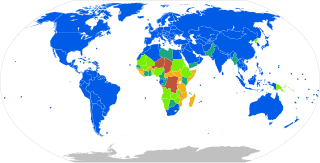
Mains electricity, also known by the American English terms utility power, power grid, domestic power, and wall power, or in some parts of Canada as hydro, is a general-purpose alternating-current (AC) electric power supply. It is the form of electrical power that is delivered to homes and businesses through electrical infrastructure in many parts of the world. People use this electricity to power everyday items—such as domestic appliances, televisions and lamps—by plugging them into a wall outlet.

Electric power distribution is the final stage in the delivery of electric power; it carries electricity from the transmission system to individual consumers. Distribution substations connect to the transmission system and lower the transmission voltage to medium voltage ranging between 2 kV and 35 kV with the use of transformers. Primary distribution lines carry this medium voltage power to distribution transformers located near the customer's premises. Distribution transformers again lower the voltage to the utilization voltage used by lighting, industrial equipment and household appliances. Often several customers are supplied from one transformer through secondary distribution lines. Commercial and residential customers are connected to the secondary distribution lines through service drops. Customers demanding a much larger amount of power may be connected directly to the primary distribution level or the subtransmission level.

IEC 60309 is a series of international standards from the International Electrotechnical Commission (IEC) for "plugs, socket-outlets and couplers for industrial purposes". The maximum voltage allowed by the standard is 1000 V DC or AC; the maximum current, 800 A; and the maximum frequency, 500 Hz. The ambient temperature range is −25 °C to 40 °C.

Mains electricity by country includes a list of countries and territories, with the plugs, voltages and frequencies they commonly use for providing electrical power to low voltage appliances, equipment, and lighting typically found in homes and offices. Some countries have more than one voltage available. For example, in North America most sockets are attached to a 120 V supply, but there is a 240 V supply available for large appliances. Often different sockets are mandated for different voltage or current levels.

Industrial and multiphase plugs and sockets provide a connection to the electrical mains rated at higher voltages and currents than household plugs and sockets. They are generally used in polyphase systems, with high currents, or when protection from environmental hazards is required. Industrial outlets may have weatherproof covers, waterproofing sleeves, or may be interlocked with a switch to prevent accidental disconnection of an energized plug. Some types of connectors are approved for hazardous areas such as coal mines or petrochemical plants, where flammable gas may be present.

A split-phase or single-phase three-wire system is a type of single-phase electric power distribution. It is the alternating current (AC) equivalent of the original Edison Machine Works three-wire direct-current system. Its primary advantage is that it saves conductor material over a single-ended single-phase system, while only requiring a single phase on the supply side of the distribution transformer.
Electrical wiring in the United Kingdom is commonly understood to be an electrical installation for operation by end users within domestic, commercial, industrial, and other buildings, and also in special installations and locations, such as marinas or caravan parks. It does not normally cover the transmission or distribution of electricity to them.

A distribution transformer or service transformer is a transformer that provides the final voltage transformation in the electric power distribution system, stepping down the voltage used in the distribution lines to the level used by the customer. The invention of a practical efficient transformer made AC power distribution feasible; a system using distribution transformers was demonstrated as early as 1882.
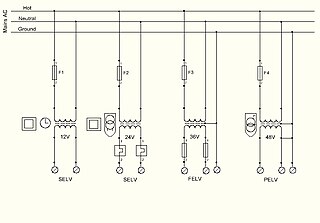
Extra-low voltage (ELV) is an electricity supply voltage and is a part of the Low voltage band in a range which carries a low risk of dangerous electrical shock. There are various standards that define extra-low voltage. The International Electrotechnical Commission member organizations and the UK IET define an ELV device or circuit as one in which the electrical potential between conductor or electrical conductor and earth (ground) does not exceed 50 V AC or 120 V DC.

A volt-ampere is the unit used for the apparent power in an electrical circuit. The apparent power equals the product of root mean square voltage and root mean square current. In direct current (DC) circuits, this product is equal to the real power in watts. Volt-amperes are usually used for analyzing alternating current (AC) circuits. The volt-ampere is dimensionally equivalent to the watt. VA rating is most useful in rating wires and switches for inductive loads.

In electric power distribution, a service drop is an overhead electrical line running from a utility pole, to a customer's building or other premises. It is the point where electric utilities provide power to their customers. The customer connection to an underground distribution system is usually called a "service lateral". Conductors of a service drop or lateral are usually owned and maintained by the utility company, but some industrial drops are installed and owned by the customer.

AS/NZS 3112 is the harmonised Australian and New Zealand standard for AC power plugs (male) and sockets (female). The standard is used in Australia, New Zealand, Fiji, Tonga, Solomon Islands, Papua New Guinea and several other Pacific island countries. The International Electrotechnical Commission (IEC) "world plugs" Web site calls this plug Type I.
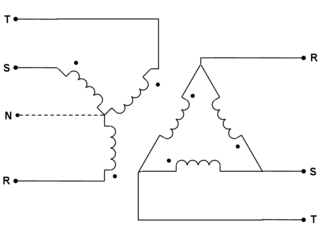
A delta-wye transformer is a type of three-phase electric power transformer design that employs delta-connected windings on its primary and wye/star connected windings on its secondary. A neutral wire can be provided on wye output side. It can be a single three-phase transformer, or built from three independent single-phase units. An equivalent term is delta-star transformer.

NEMA connectors are power plugs and receptacles used for AC mains electricity in North America and other countries that use the standards set by the US National Electrical Manufacturers Association. NEMA wiring devices are made in current ratings from 15 to 60 amperes (A), with voltage ratings from 125 to 600 volts (V). Different combinations of contact blade widths, shapes, orientations, and dimensions create non-interchangeable connectors that are unique for each combination of voltage, electric current carrying capacity, and grounding system.
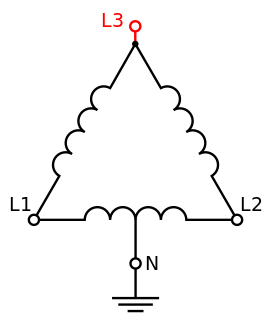
High-leg delta is a type of electrical service connection for three-phase electric power installations. It is used when both single and three-phase power is desired to be supplied from a three phase transformer. The three-phase power is connected in the delta configuration, and the center point of one phase is grounded. This creates both a split-phase single phase supply and three-phase. It is called "orange leg" because the wire is color-coded orange. By convention, the high leg is usually set in the center lug in the involved panel, regardless of the L1-L2-L3 designation at the transformer.
In electrical engineering, low voltage is a relative term, the definition varying by context. Different definitions are used in electric power transmission and distribution, and electrical safety codes define "low voltage" circuits that are exempt from the protection required at higher voltages. These definitions vary by country and specific codes or regulations.
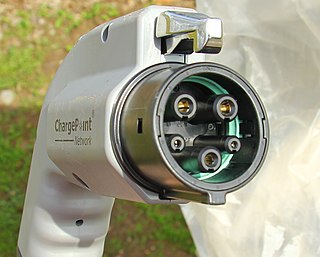
SAE J1772, also known as a J plug, is a North American standard for electrical connectors for electric vehicles maintained by the SAE International and has the formal title "SAE Surface Vehicle Recommended Practice J1772, SAE Electric Vehicle Conductive Charge Coupler". It covers the general physical, electrical, communication protocol, and performance requirements for the electric vehicle conductive charge system and coupler. The intent is to define a common electric vehicle conductive charging system architecture including operational requirements and the functional and dimensional requirements for the vehicle inlet and mating connector.

SAE J3068 is a North American recommended practice published and maintained by SAE International. J3068 defines electrical connectors and a control protocol for electric vehicles. It has the formal title "SAE Surface Vehicle Recommended Practice J3068". J3068 defines a system of conductive power transfer to an electric vehicle using a coupler capable of transferring single-phase and three-phase AC power as well as DC power, and defines a digital communication system for control. J3068 also specifies requirements for the vehicle inlet, supply equipment connector, mating housings and contacts.















